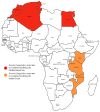Review of Lyme Borreliosis in Africa-An Emerging Threat in Africa
- PMID: 39596852
- PMCID: PMC11591761
- DOI: 10.3390/biology13110897
Review of Lyme Borreliosis in Africa-An Emerging Threat in Africa
Abstract
Lyme borreliosis (LB) is more common in the Northern Hemisphere. It is endemic mainly in North America, where the vectors are Ixodes scapularis and Ixodes pacificus, and in Eurasia, where the vectors are Ixodes ricinus and Ixodes persulcatus. Both tick-borne diseases and LB are influenced by climate change. Africa and South America are crossed by the equator and are situated in both the Northern and Southern Hemispheres. In Africa, the LB is present on the Mediterranean and the Indian Ocean coasts. Borrelia lusitaniae is prevalent in countries bordering the Mediterranean Sea, such as Tunisia, Morocco, Algeria, and Egypt. Ticks were detected in the Ixodes Ricinus, which are carried by migratory birds and the Ixodes inopinatus and captured by the Psammodromus algirus lizards. The Borreliae Lyme Group (LG) and, in particular, Borrelia garinii, have been reported in countries bordering the Indian Ocean, such as Kenya, Tanzania, and Mozambique, transported by migratory birds from North African countries, where the vector was identified as Hyalomma rufipes ticks. This review aims to document the presence of Borreliae LG and LB in Africa.
Keywords: Borreliae Lyme Group; erythema migrans; migratory birds; neuroborreliosis; reservoirs; ticks.
Conflict of interest statement
The authors declare no conflicts of interest.
Figures
References
-
- Margos G., Fedorova N., Becker N.S., Kleinjan J.E., Marosevic D., Krebs S., Hui L., Fingerle V., Lane R.S. Borrelia maritima sp. nov., a novel species of the Borrelia burgdorferi sensu lato complex, occupying a basal position to North American species. Int. J. Syst. Evol. Microbiol. 2020;70:849–856. doi: 10.1099/ijsem.0.003833. - DOI - PubMed
-
- Trevisan G., Cinco M., Ruscio M., Forgione P., Bonoldi V.L.N., Falkingham E., Trevisini S., Tranchini P., Bonin B., Yoshinari N.H. Borrelia Lyme Group. J. Dermatol. Res. Rev. Rep. 2022;3:1–12. doi: 10.47363/JDMRS/2022(3)142. - DOI
Publication types
LinkOut - more resources
Full Text Sources


